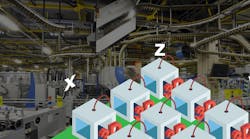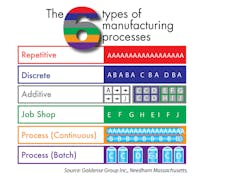The arrival of Additive Manufacturing (AM) as a valid alternative to the original five manufacturing processes is really going to shake up the factory. Within 3 to 5 years, engineering and manufacturing leaders will look out at their production floors and wonder if they should tool-up or modify an assembly line for a new product or just buy the 3D or Metal AM machines they need for the volume they anticipate.
The 6 Types of Manufacturing Processes (Aug '18 MD) discusses the history and readiness of 3D rapid prototyping to mature quickly into reliable Additive Manufacturing and its resultant transformational effects on several industries. This article focuses on AM's impact on historical manufacturing processes.
AM Impact on The Original 5 Types: How much will Additive Manufacturing affect the five types of manufacturing processes? Well, as it turns out, there will be changes in two major groups. 3D Printing focused on components, machines, and equipment will alter three of the five processes: Repetitive, Discrete, and Job Shop. 3D Printing focused on vessels, organs, and tissues will shake-up one of the remaining two traditional processes. Today, tissues are built from printed cells and other formulations that create functioning cellular structures. 3D Printing in life sciences is not as mature, but eventually it will become a viable alternative to Batch Process production. Almost by definition, 3D Printing can never become fully Continuous Process production. But, it is too early to decide that for sure. The 5 Types of Manufacturing Processes (Sept '15 MD) goes into each of the five original processes in more detail.
AM Impact on Repetitive Manufacturing: Repetitive manufacturing is the Continuous Process for component-based products. It is as close as you can get to fluids and slurries flowing in a pipe continuously. Yes, it can be speeded-up and slowed-down, just like fluids in a pipe or channel. The classic example of Repetitive is Hasbro. They have production lines that make G.I. Joe and Barbie dolls 24/7, 365, one after the other. Maybe in the future, 3D printing will run at the speeds and costs that those 24/7 lines run at. For now, there will not be much impact. The volume requirements are simply too great.
That said, many products running on those lines are first prototyped using 3D printing. 3D-printed designs are already affecting their transition to mass production lines.
AM Impact on Discrete Manufacturing: Discrete manufacturing is much the same as Repetitive, except slower and with lower volumes. Discrete manufacturing also typically uses less automation. Volumes can be so low that it is not economical to dedicate just one product to the line, so the lines need to be torn down and changed over to run other product(s). When customer order or build-to-inventory points are triggered, the original product is set up again. Depending on the equipment’s flexibility, the line workers’ skills, and the time and cost of a changeover, several different product types may run on the same line.
AM will make the largest economic impact on Discrete manufacturing. Products whose run volumes are highly intermittent might be the first to switch to AM. Those changeovers will be eliminated, as will be the non-conforming product run after the changeover until products meet the quality spec. Erosion will grow as the speed of reliable 24/7, 365 printing grows. And, 3D printing can run a third shift. It might only need to be two-thirds as fast to turn out the same amount in a day.
AM Impact on Job Shop Manufacturing: Job Shop manufacturing is the lowest volume process and it uses little automation. All types of complex automated equipment might be needed to fashion unique or low-volume parts, but that is at the component level. Making the final product typically requires a great deal of human time and talent. Certain products, simply because of their large size or other physical characteristics that make them unwieldy, could be Discrete products but are typically Job Shop.
AM will have the largest overall effect on Job Shop. Job Shop products typically have high design and prove-out costs relative to their production volumes. The workers’ skill level and versatility in Job Shops is high, as are their cost. Much will be done in 3D in design and proved-out by 3D printing. Printed products typically have far fewer parts. The writing is on the wall for low volume manufacturing.
See part one of this article on The 6 Types of Manufacturing Processes in my MD August 2018 column.
See the original article containing detailed descriptions of the The 5 Types of Manufacturing Processes in my MD September 2015 column.


